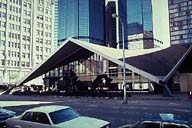
|
Image-GoddenE45
Hypar roof, Court House Square. Designed to house a shop, this large concrete shell covers an area of 112 ft X 113.5 ft without interior supports and rises 32.5 ft above ground. The shell thickness is 3 in. increasing to 6 in. at the ridges. (Denver, Colorado)
|
|
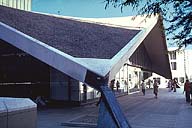
|
Image-GoddenE46
Detail of one of the supporting buttresses in the hypar shell roof. Each buttress is oriented in the diagonal of the shell as viewed in plan. This is the direction of the resultant force exerted by the two edge beams at the corner. (Denver, Colorado)
|
|
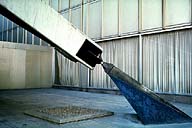
|
Image-GoddenE47
Side view of steel buttress. Note that the buttress is inclined at an angle to the vertical in line with the edge beams, to be in line with the resultant boundary force. (Denver, Colorado)
|
|
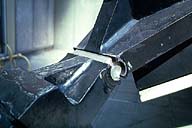
|
Image-GoddenE48
Hinged joint at the top of the buttress. The complete shell is supported on four stainless steel pins. (Denver, Colorado)
|
|
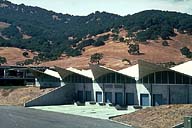
|
Image-GoddenE49
Office building. Consisting of a series of hypar shells designed in such a way that half a shell is cantilevered above the main windows. (Near San Francisco, California)
|
|
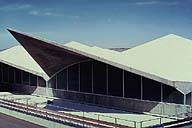
|
Image-GoddenE50
Cantilevered shell. The concrete edge beam tapers from minimum at the unsupported end to maximum at the support point. (San Francisco Bay Area)
|
|
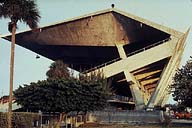
|
Image-GoddenE51
Marine Stadium. This structure facing the waterfront for water sports is roofed with a series of hypar shells. The geometry of the shells and the structural system at the back of the stadium can be seen in GoddenE52. (Miami, Florida)
|
|
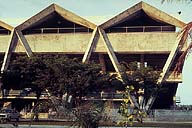
|
Image-GoddenE52
Marine Stadium. Close-up of two bays of the stadium taken from the back. The diagonal members act as ties for the long cantilever roof as well as providing in-plane stability to the structure. (Miami, Florida)
|
|
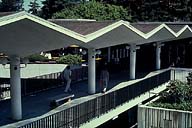
|
Image-GoddenE53
Hypar roof, University of California, Berkeley. Each column supports an umbrella roof consisting of four small hypar shells. The column spacing is 20 ft. (Berkeley, California)
|
|

|
Image-GoddenE54
Hypar roof, University of California, Berkeley. Each column supports an umbrella roof consisting of four small hypar shells. The column spacing is 20 ft. (Berkeley, California)
|
|

|
Image-GoddenE55
Hypar roof, University of California, Berkeley. This roof system is also used as a restaurant roof. Note the interesting geometry and high window opening caused by staggering the alternate rows of shells. (Berkeley, California)
|
|
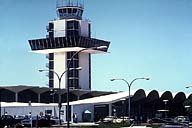
|
Image-GoddenE56
Oakland International Airport. This central tower-terminal building uses hypar umbrella shells over the main hall, and cantilevered barrel shells at the entrance. (Oakland, California)
|
|
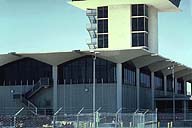
|
Image-GoddenE57
Umbrella hypar shells in the Oakland Airport tower-terminal building. Each set of four hypar shells is independently supported on a long central column. The column spacing is 35 ft. (Oakland, California)
|
|
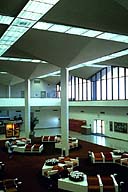
|
Image-GoddenE58
Interior view of Oakland Airport tower/terminal building showing the arrangement of the hypar shells. (Oakland, California)
|
|

|
Image-GoddenE59
St. Mary's Cathedral. An interesting structure consisting of eight hypar shells on end forming a total roof structure. The form of the building is difficult to visualize, hence views from different angles, both inside and outside the cathedral, are shown in GoddenE60-E63. (San Francisco, California)
|
|
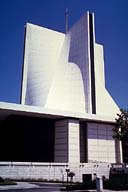
|
Image-GoddenE60
Oblique external view of St. Mary's Cathedral, showing the ridge between the shell pairs at the corners of the building in plan. The line extends from the center of the cross at the apex of the building and descends in a straight line to the support point shown in GoddenE63. (San Francisco, California)
|
|
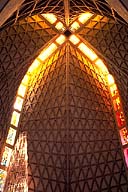
|
Image-GoddenE61
St. Mary's Cathedral. Interior view looking upwards and showing the mid-point at the apex. The form of the roof can be deduced from GoddenE60-E61. (San Francisco, California)
|
|
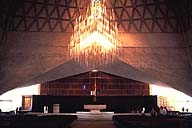
|
Image-GoddenE62
St. Mary's Cathedral. Interior view, floor level looking towards the altar. Note that the shells are terminated at the bottom in an arch form between the supports (two of the supports are just out of view to the left and right, but a close-up of one of the supports is given in GoddenE63) giving an outside view from the cathedral floor. (San Francisco, California)
|
|
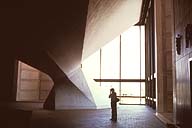
|
Image-GoddenE63
St. Mary's Cathedral. Interior View, showing one of the four corner shell supports. (San Francisco, California)
|
|
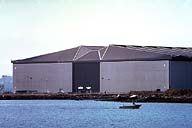
|
Image-GoddenE64
American Airlines Hangar, SFO. This double cantilever roof structure consists of a series of hypar shells made of this steel decking. Cantilevers are 230 ft. long, 56 ft. wide, and have a depth that tapers from 40 ft. maximum to 4 ft. at the tip. The bottom of the roof is 80 ft. above the floor. Built on a module design, the roof currently has eight pairs of balanced hypars. (San Francisco International Airport)
|
|
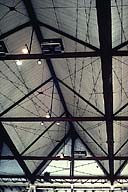
|
Image-GoddenE65
American Airlines Hangar, SFO. Interior view. The point of support of the hypars is seen in the background, and the flattening angle between plates can be seen by comparing the background and foreground geometry. The roof includes a set of cables that can be tightened to counteract vertical displacements. The top of the cantilever (over the hangar doors) is off the top of the slide. (San Francisco International Airport)
|
|























